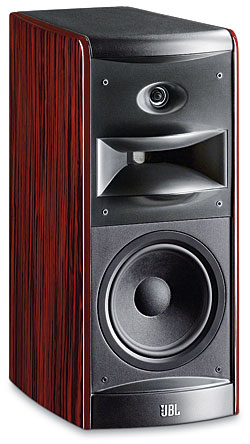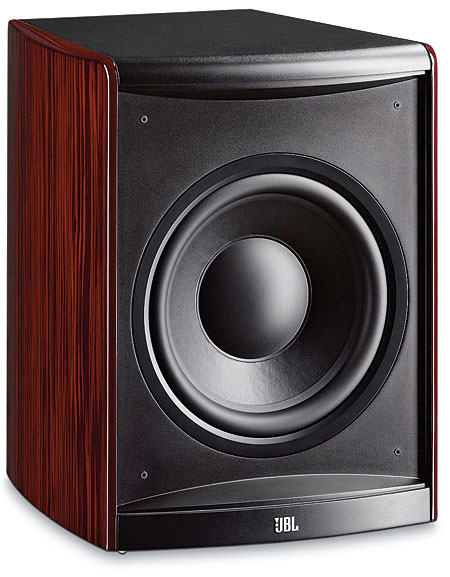JBL LS40 Speaker System

Two-Horned Demon
Hey you. Did you notice what I just did when I yelled at you? I cupped my hands around my mouth. That guided my voice’s acoustic output toward your ears. It also limited its off-axis response to reduce room interaction, enabling you to hear me better. You probably noticed that it also introduced an added coloration to the sound of my voice. But you heard me, didn’t you?
A history of the horned loudspeaker would fill several pages, but perhaps a few highlights would suffice. The basic technology behind the megaphone goes back to the 17th century. Horns first appeared in audio equipment with the gramophones of the 19th century. James B. Lansing, who would eventually found JBL, used horns in the sound systems he co-designed for MGM in the mid-1930s. JBL’s horned speakers have been used in movie theaters ever since. JBL continued to refine horned speaker technology with the Bi-Radial horn, developed in the late 1970s.
Nowadays, JBL operates under the aegis of Harman International. The brand operates in both the professional and home spheres across a wide range of price points. I’ve always paid a lot of attention to JBL, as it is one of the few respectable speaker brands that budget-oriented consumers are likely to find in the mega-retailer environment. But today’s subject, the JBL Performance LS Series, is a product of the Harman High Performance AV Group. Although they aren’t terribly expensive by high-end standards, these speakers leverage Harman’s world-class engineering resources and continue trains of design thought that are distinctively JBL, especially in the use of horns.
 Big Horn, Little Horn
Big Horn, Little Horn
The Performance LS Series includes two towers, the LS80 ($1,499 each) and LS60 ($1,099 each), not reviewed here; plus our review subjects, the chunky LS40 monitor ($699 each), LS Center ($799), and LS120P subwoofer ($1,099). The LS40 is fairly big for a monitor speaker, at nearly 20 inches tall, and the center is well over 2 feet wide.
All of the Performance LS speakers have medium-density-fiberboard enclosures adorned with high-gloss side panels in either ebony or mahogany, which greatly enhance the speakers’ looks. The sides curve inward toward the back, which reduces the tendency of standing waves to develop inside the enclosure and muddy the sound.
These speakers use a threeway design, although it isn’t the conventional tweeter-midrange-woofer array. Instead, the LS40 and LS Center include what I would call a supertweeter, a regular tweeter, and a woofer (two woofers in the LS Center). If you prefer JBL’s parlance, the sales brochure calls them the ultrahigh-frequency (UHF), high-frequency (HF), and low-frequency transducers. Both tweeters hide in the throats of horns, so if you’re feeling jocular, you might refer to them as Big Horn and Little Horn. The crossover frequencies are stated as 7 kilohertz between Little Horn and Big Horn, and 2.6 kHz between Big Horn and No Horn (the woofer). Are we having fun?
The supertweeter or UHF is a 0.75-inch polyimide ring radiator with a fluid-cooled neodymium magnet recessed in a small waveguide or “oval-shaped short horn.” JBL’s ring radiators go all the way back to the 1940s, when they were called JBL Bullets. The equalizer, or phase plug, at the center retains the bullet shape. According to the literature, its job is to “control energy attenuation caused by phase interference, for smoother overall response.” The driver’s diaphragm, surround, and voice coil superstructure are molded in a single piece.
Long-time readers of JBL spec sheets will recognize the materials that the other two drivers are made of. The tweeter—or HF Compression Driver—is a 2-inch pure titanium dome with a lightweight aluminum voice coil in a Bi-Radial horn. My tape measure says the horn is 7 inches wide by 3 inches high at the outside. The driver is deep inside it, a good 4 inches inward from the surface of the baffle. In addition to providing strict directivity control (hey you) and minimizing room reflections, the horn also helps prevent interference between the two tweeters.
All of the low-frequency drivers—including the woofer in the LS40, the two woofers in the LS Center, and the 12-inch woofer in the LS120P—are made of pure pulp fiber. JBL uses hightemperature voice coils with Kapton formers and center-pole vents to minimize compression and distortion at high volumes.

The center-channel speaker comes with three screw-in rubber feet. As an alternative, you could screw in a set of 0.25-inch metal cones (which the manual calls spikes, although they’re not terribly sharp) and rest them on 1.5-inch-wide metal coasters. The coasters and cones are also packed with the sub, but not with the LS40. Speaker terminals are gold-nut binding posts, in biwire configuration on the LS40 but not on the LS Center. The curved grilles are extremely sturdy, with fabric over a plastic frame and metal pins that fit tightly into rubber anchors. The monitor and sub are rear ported, but the center’s enclosure is sealed.






























































